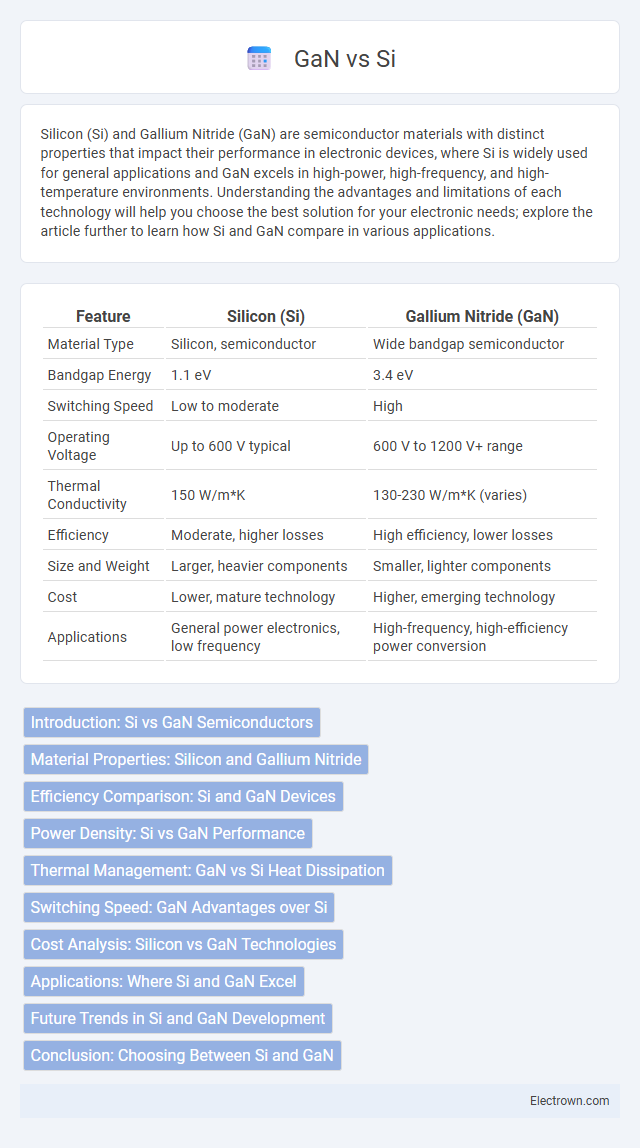Silicon (Si) and Gallium Nitride (GaN) are semiconductor materials with distinct properties that impact their performance in electronic devices, where Si is widely used for general applications and GaN excels in high-power, high-frequency, and high-temperature environments. Understanding the advantages and limitations of each technology will help you choose the best solution for your electronic needs; explore the article further to learn how Si and GaN compare in various applications.
Table of Comparison
| Feature | Silicon (Si) | Gallium Nitride (GaN) |
|---|---|---|
| Material Type | Silicon, semiconductor | Wide bandgap semiconductor |
| Bandgap Energy | 1.1 eV | 3.4 eV |
| Switching Speed | Low to moderate | High |
| Operating Voltage | Up to 600 V typical | 600 V to 1200 V+ range |
| Thermal Conductivity | 150 W/m*K | 130-230 W/m*K (varies) |
| Efficiency | Moderate, higher losses | High efficiency, lower losses |
| Size and Weight | Larger, heavier components | Smaller, lighter components |
| Cost | Lower, mature technology | Higher, emerging technology |
| Applications | General power electronics, low frequency | High-frequency, high-efficiency power conversion |
Introduction: Si vs GaN Semiconductors
Silicon (Si) and gallium nitride (GaN) are key semiconductor materials with distinct properties affecting electronic device performance. Si offers mature fabrication technology and cost efficiency, while GaN excels in high electron mobility, wide bandgap, and thermal stability, enabling superior power efficiency and higher frequency operation. Your choice between Si and GaN impacts device speed, power density, and thermal management in applications like power electronics and RF systems.
Material Properties: Silicon and Gallium Nitride
Silicon (Si) offers established semiconductor properties such as moderate bandgap energy (1.1 eV) and high electron mobility, making it ideal for conventional electronics and power devices operating at lower voltages. Gallium Nitride (GaN) possesses a wide bandgap (3.4 eV), high electron saturation velocity, and superior thermal conductivity, enabling higher voltage operation, faster switching speeds, and improved efficiency in high-frequency applications. Your choice between Si and GaN depends on performance requirements, where GaN provides enhanced material properties for demanding power conversion and RF systems.
Efficiency Comparison: Si and GaN Devices
Gallium Nitride (GaN) devices demonstrate significantly higher efficiency than Silicon (Si) counterparts due to lower conduction and switching losses, enabling faster switching frequencies and reduced heat generation. Your power electronics benefit from GaN's superior electron mobility and wider bandgap, which translate to improved energy conversion efficiency and compact system design. In contrast, Si devices, while cost-effective and mature, exhibit higher resistance and slower switching speeds, limiting their efficiency in high-performance applications.
Power Density: Si vs GaN Performance
GaN devices deliver significantly higher power density compared to silicon, enabling smaller and lighter power modules without compromising performance. This increased power density results from GaN's superior electron mobility and higher breakdown voltage, allowing efficient operation at higher frequencies and temperatures. Your power systems benefit from enhanced efficiency and reduced thermal management requirements when choosing GaN over traditional silicon components.
Thermal Management: GaN vs Si Heat Dissipation
GaN semiconductors exhibit superior thermal conductivity compared to traditional silicon, enabling more efficient heat dissipation in high-power applications. This enhanced thermal management reduces the need for bulky cooling systems, improving device reliability and performance. Your choice of GaN technology can result in cooler operation and longer lifespan for electronic components under intense thermal stress.
Switching Speed: GaN Advantages over Si
GaN (Gallium Nitride) semiconductors exhibit significantly higher switching speeds compared to traditional Silicon (Si) devices due to their wide bandgap and superior electron mobility. These properties enable GaN transistors to operate efficiently at higher frequencies with reduced switching losses, making them ideal for high-speed power conversion and RF applications. By choosing GaN technology, your systems can achieve faster switching performance and increased energy efficiency.
Cost Analysis: Silicon vs GaN Technologies
Silicon (Si) technology remains more cost-effective due to its mature manufacturing infrastructure and abundant raw materials, resulting in lower wafer and processing expenses compared to Gallium Nitride (GaN). GaN devices, though offering superior performance in high-frequency and high-efficiency applications, incur higher production costs driven by complex epitaxial growth, limited substrate availability, and smaller economies of scale. Cost analysis often favors Si for large-volume, low-cost applications, while GaN justifies its premium in energy-efficient and high-power-density designs where performance gains offset material and fabrication expenses.
Applications: Where Si and GaN Excel
Silicon (Si) dominates in mainstream electronics, powering microprocessors, memory devices, and standard power supplies, where cost-effectiveness and established manufacturing are critical. Gallium Nitride (GaN) excels in high-frequency, high-efficiency applications such as RF amplifiers, fast-charging adapters, and electric vehicle inverters due to its superior electron mobility and thermal conductivity. GaN's ability to operate at higher voltages and temperatures makes it ideal for emerging technologies in 5G communications and renewable energy systems.
Future Trends in Si and GaN Development
Future trends in Si and GaN development emphasize GaN's superior efficiency and high-frequency performance, driving its adoption in power electronics and RF applications. Silicon technology continues to evolve with advanced silicon carbide (SiC) integration, enhancing thermal management and robustness in high-power devices. Research focuses on hybrid solutions combining Si and GaN to optimize cost-effectiveness and performance for next-generation energy-efficient systems.
Conclusion: Choosing Between Si and GaN
Choosing between silicon (Si) and gallium nitride (GaN) depends on specific application requirements such as efficiency, power density, and thermal performance. GaN devices offer higher efficiency, faster switching speeds, and better thermal management compared to traditional Si components, making them ideal for high-frequency and high-power applications. Silicon remains cost-effective and widely compatible with existing manufacturing processes, suitable for lower power or cost-sensitive uses.
Si vs GaN Infographic

 electrown.com
electrown.com